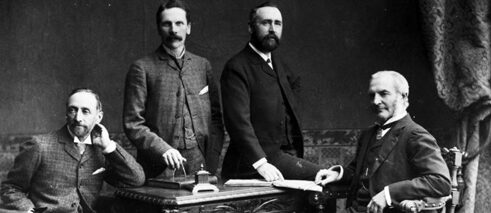Traces in other regions
Harland & Wolff shipyard

“Samson” and “Goliath”, two Belfast landmarks: dominating the city skyline, these yelllow gantry cranes belong to Harland & Wolff, the shipyard where the “Titanic” was built.
Harland & Wolff wielded huge politic influence too: Catholics were rarely hired. The second part of the company name belonged to Gustav Wolff, born in Hamburg in 1834. Originally Jewish, his parents had converted to Protestantism in 1819. When he was 15, Wolff moved to Liverpool to join an uncle. He served an apprenticeship in Manchester and worked as a draughtsman until shipbuilder Edward Harland of Belfast hired him as his personal assistant. Harland made him a partner in 1861. Wolff sat as a Member of Parliament in Westminster for 18 years, representing the Conservative and Unionist Party. By the time RMS Titanic was launched in 1911, Wolff was long retired and living in London, where he died in 1913. Today, the impressive entrance lobby and drawing offices of the former Harland & Wolff headquarters have been restored, as have the dry dock where the ship was built and the slip from which it was launched.
Just in time for the centenary of the sinking of the Titanic (in the early hours of 15 April 1912), a visitor centre costing £100 million was opened, near where the ship was originally built. Here visitors can follow the ship’s story from the drawing board to its watery end. Meanwhile, shipbuilding at Harland & Wolff has come to an end too: one of the biggest shipyards in the world in its heyday, it now mostly produces turbines for offshore wind farms.
Visitor Information:
Titanic Belfast
1 Olympic Way Queen's Road
Titanic Quarter
Belfast
Northern Ireland
BT3 9EP
+44 (0)28 9076 6399
welcome@titanicbelfast.com